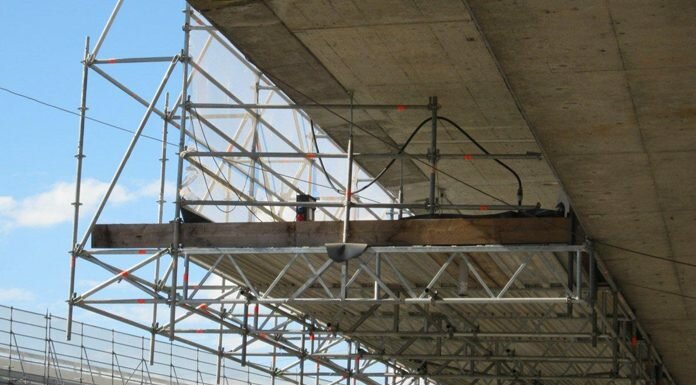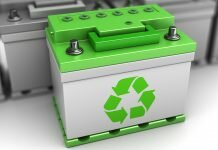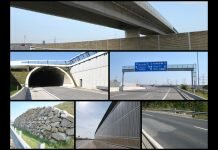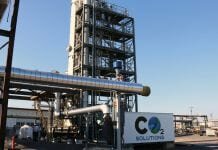
Professor Dr Ueli Angst and Professor Dr Bernhard Elsener, ETH Zurich, Institute for Building Materials
Conventional building materials
Reinforced concretes are the world’s most used man-made building materials, especially for civil infrastructure such as bridges, tunnels, marine structures, sewer systems, and dams. With a long and proven track record regarding structural safety and durability, these engineering structures are of crucial importance for economy and society.
Despite the proven durability of reinforced concrete, the structures are ageing, and beginning to show signs of degradation due to the corrosion of the reinforcing steel when chloride ions from seawater, or de-icing salts or carbonation, destroy the protective passive film on the steel.
The required repair work not only consumes energy and materials but negatively impacts the environment. Additionally, corrosion of the infrastructures leads to very high costs, estimated in the order of 1.5% of annual gross domestic product (GDP). The cost of corrosion of reinforced concrete infrastructure in the US is calculated to about 50 x 109 dollars per year.
International developments
In industrialised countries, the major part of infrastructure was built in the years between 1960 and 1980, thus they have reached or are reaching a critical age when major maintenance work has to be performed. The continuous ageing of these existing assets will lead to an increased need of repair: as reported by Polder et al.1
For the Netherlands, for example, it has been estimated that structures needing repair will increase in the next 20 years by a factor of two to four, and over the next 40 years by a factor three to six. Despite these huge numbers this tremendous actual and future financial burden receives comparatively little attention.
In emerging countries, the civil engineering infrastructure is being expanded and built today, the main challenge is that these new structures have to be designed and constructed durably. As was discussed at the international RILEM workshop on present and future durability challenges for reinforced concrete structures, held in Zurich, Switzerland, in 2012, building new structures and maintaining existing ones operates “in the context of an ever-increasing need to reduce the overall environmental impact of this infrastructure, while selecting practical and cost-effective solutions. More specifically, this will mean to combine long service life and low environmental footprints of the materials used”.2
Building materials for infrastructure
Infrastructure is a key factor in the competitiveness of countries – neglecting the maintenance of the structures limits economic growth. Given the already high and increasing number of degrading structures, there is an ever-increasing need to cost-effectively maintain existing, ageing infrastructure.
Today, maintenance and repair is often performed by removing structurally sound but chloride contaminated or carbonated concrete, replacing it with new, alkaline concrete in order to re-establish the protective properties for the steel reinforcement. The costs of these repairs are high, the success is limited and often after a relatively short time repair work is needed again. Such conservative, experience-based repair options have to be abandoned and instead more science-based repair principles should be used. This requires great efforts in research – and it is here where our group, Durability of Engineering Materials at ETH Zurich – one of the principal research groups in this field worldwide – will contribute.
In the following, some of the ongoing research projects are outlined; more information can be found on the website.
Condition assessment of reinforced structures
A reliable condition assessment that especially able to detect and quantify the extent of corrosion is the basis for any repair strategy. Half-cell potential mapping is the state-of-the-art technique applied. The limited accessibility to structures, e.g. bridge deck underside, high pillars etc., requires costly equipment and manpower. Novel approaches using robots or drones might facilitate a more widespread use of half-cell potential mapping and other NDT techniques.
Non-destructive corrosion rate measurements
In many situations corrosion occurs as either localised or galvanic, i.e. the anodic and cathodic areas are spatially separated. Examples are chloride-induced corrosion of steel in concrete or corrosion in water utility systems. Being able to measure the rate at which corrosion occurs is crucial for research and practice. This project seeks to deliver a fundamentally sound method for measuring corrosion rates in localised corrosion, and thus to overcome the limitations of the commonly used techniques such as polarisation resistance measurements.
Initiation of chloride induced corrosion
Being able to predict the initiation of chloride-induced corrosion of steel in concrete is crucial for service life modelling of concrete structures. After 60 years with a concept that failed to reliably predict corrosion initiation, this project seeks to provide a novel, materials science-based approach to describe the initiation of corrosion of steel in concrete.
Diffusion potentials in concrete
Diffusion potentials may act as a serious error source in electrochemical measurements and thus, negatively, various non-destructive test methods used in condition assessments of concrete structures. On the other hand, diffusion potentials may also be used as source of information, i.e. with respect to the pore structure of the material or concerning the distribution of chemical species in the pore solution. This project aims at improving the understanding of diffusion potentials in porous materials, particularly in concrete.
Corrosion rate of steel in carbonated concrete
The use of new, clinker-reduced binders increases the carbonation rate. Thus the propagation phase of corrosion makes part of the required service life. Corrosion rate data measured in carbonated mortar made with new binders can be determined rapidly with a new test-setup developed in our group. Research is ongoing to get a better mechanistic understanding of corrosion of steel in carbonated concrete.
ETH Zurich, Institute for Building Materials foci
Our research focuses on the durability of infrastructures, particularly on corrosion of steel in concrete and other engineering environments. New results will improve the scientific understanding of the main degradation mechanisms and contribute to a knowledge-based approach to forecast the durability performance of our infrastructure. In order to become effective and contribute to solve the infrastructure problems outlined above, this knowledge has to be transferred to engineering practice. The education of a new generation of professionals, the training of civil engineers in practice, performance of applied research projects, and – last but not least – committee work to write the future standards are the future challenges to be addressed.3
References
- RB Polder, WHA Peelen and WMG Courage, Mater. Corros. 63 (2012) 1147–1153
2. UM Angst, RD Hooton, J Marchand, CL Page, RJ Flatt, B Elsener, C Gehlen and J Gulikers, Present and future durability challenges for reinforced concrete structures, Mater. Corros. 63 (2012) 1047–1051
3. UM Angst, Challenges and opportunities in corrosion of steel in concrete, Lecture for the RILEM Robert L’Hermite Medal 2017, Materials and Structures (2017)























